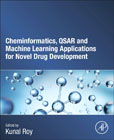
Cheminformatics, QSAR and Machine Learning Applications for Novel Drug Development
Roy, Kunal
Cheminformatics, QSAR and Machine Learning Applications for Novel Drug Development aims at showcasing different structure-based, ligand-based, and machine learning tools currently used in drug design. It also highlights special topics of computational drug design together with the available tools and databases. The integrated presentation of chemometrics, cheminformatics, and machine learning methods under is one of the strengths of the book. The first part of the content is devoted to establishing the foundations of the area. Here recent trends in computational modeling of drugs are presented. Other topics present in this part include QSAR in medicinal chemistry, structure-based methods, chemoinformatics and chemometric approaches, and machine learning methods in drug design. The second part focuses on methods and case studies including molecular descriptors, molecular similarity, structure-based based screening, homology modeling in protein structure predictions, molecular docking, stability of drug receptor interactions, deep learning and support vector machine in drug design. The third part of the book is dedicated to special topics, including dedicated chapters on topics ranging from de design of green pharmaceuticals to computational toxicology. The final part is dedicated to present the available tools and databases, including QSAR databases, free tools and databases in ligand and structure-based drug design, and machine learning resources for drug design. The final chapters discuss different web servers used for identification of various drug candidates. Presents chemometrics, cheminformatics and machine learning methods under a single reference Showcases the different structure-based, ligand-based and machine learning tools currently used in drug design Highlights special topics of computational drug design and available tools and databases INDICE: Section I: Introduction 1. Quantitative structure-activity relationships (QSARs) in medicinal chemistry 2. Computer-aided Drug Design - An overview 3. Structure-based virtual screening in Drug Discovery 4. The impact of Artificial Intelligence methods on drug design Section 2. Methods and Case studies 5. Graph Machine Learning in Drug Discovery 6. Support Vector Machine in Drug Design 7. Understanding protein-ligand interactions using state-of-the-art computer simulation methods 8. Structure-based methods in drug design 9. Structure-based virtual screening 10. Deep learning in drug design 11. Computational methods in the analysis of viral-host interactions 12. Chemical space and Molecular Descriptors for QSAR studies 13. Machine learning methods in drug design 14. Deep learning methodologies in drug design 15. Molecular dynamics in predicting stability of drug receptor interactions Section 3. Special topics 16. Towards models for bioaccumulation suitable for the pharmaceutical domain 17. Machine Learning as a Modeling Approach for the Account of Nonlinear Information in MIA-QSAR Applications: A Case Study with SVM Applied to Antimalarial (Aza)aurones 18. Deep Learning using molecular image of chemical structure 19. Recent Advances in Deep Learning Enabled Approaches for Identification of Molecules of Therapeutics Relevance 20. Computational toxicology of pharmaceuticals 21. Ecotoxicological QSAR modelling of pharmaceuticals 22. Computational modelling of drugs for neglected diseases 23. Modelling ADMET properties based on Biomimetic Chromatographic Data 24. A systematic chemoinformatic analysis of chemical space, scaffolds and antimicrobial activity of LpxC inhibitors Section 4. Tools and databases 25. Tools and Software for Computer Aided Drug Design and Discovery 26. Machine learning resources for drug design 27. Building Bioinformatics Web Applications with Streamlit 28. Free tools and databases in ligand and structure-based drug design
- ISBN: 978-0-443-18638-7
- Editorial: Academic Press
- Encuadernacion: Rústica
- Páginas: 768
- Fecha Publicación: 25/05/2023
- Nº Volúmenes: 1
- Idioma: Inglés
